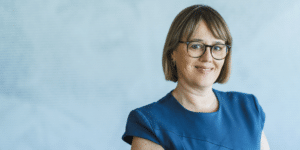
At the heart of Dr Cathy Morgan’s research is a very simple question – how do we give newborn babies at high risk of cerebral palsy the best possible start to life?
It wasn’t too long ago that this question wasn’t even on the radar of many medical professionals. Historically, it was believed that a diagnosis of cerebral palsy was not possible until the second year of life, meaning that newborn babies at high risk of cerebral palsy were missing out on vital therapy.
Thankfully, recent decades have seen huge strides forward in our understanding of cerebral palsy, with a series of tools and assessments developed to enable medical professionals to make a diagnosis with a high degree of certainty as young as three months of age.
Why is early diagnosis so important? The first months of life is a crucial period when neuroplasticity – the brain’s ability to change, adapt and develop new connections – is at its highest. This means early intervention can have a big impact on the trajectory of a child’s life. And as children receive access to therapy earlier than ever before, a second question has emerged – what types of therapy deliver the best results for infants with cerebral palsy?
Now a research team led by Dr Morgan is working to answer this crucial question with the introduction of GAME (Goals, Activity, Motor Enrichment), a world-first therapy approach developed by Cathy and Cerebral Palsy Alliance colleagues. The GAME trial aims to empower parents to support their children through development and learning at home, where the majority of a baby’s development happens.
“GAME is a package approach to early intervention. It combines what we know about how newborns learn through task-specific motor training with parent coaching – working alongside parents in their own home to train them how to practice these activities with their children and enrich their environments,” says Cathy.
After earlier, smaller pilot trials of GAME showed promising results, a multi-disciplinary team of researchers are putting it to the test in the biggest-ever training study conducted for infants with cerebral palsy – recruiting more than 300 babies across four states.
With this study, we’re trying to get three things right – the right kids, with the right intervention, at the right time. And if we bring these all together in a large study, it will tell us a great deal about how we can get the best outcomes for babies with cerebral palsy
“The way we treat cerebral palsy has evolved and shifted to be more goal-oriented, but it has taken us longer to get to that point for babies. The aim is now to take the principles that we know work for older children with cerebral palsy and adapt them appropriately for use with infants,” says Cathy.
Researchers hope that this scale, combined with an evidence-based approach to conducting the trial and analysing the results, will give us valuable new understanding of how to maximise neuroplasticity and set infants with cerebral palsy up for the best possible future.
“With this study, we’re trying to get three things right – the right kids, with the right intervention, at the right time. And if we bring these all together in a large study, it will tell us a great deal about how we can get the best outcomes for babies with cerebral palsy,” says Cathy.
“When a family receives a diagnosis of a childhood disability, there is so much to do and parents have to navigate that out of nowhere. There are lots of therapy options and lots of people selling products, but what we really need is therapy that is proven to work through rigorously conducted studies that follow good scientific practice.”
So, what’s next? The study is ongoing, with therapy being conducted and data still being collected at a number of sites around the country. Once the study is completed and the results analysed in 2023, we’ll know much more about what types of therapy help infants with cerebral palsy.
